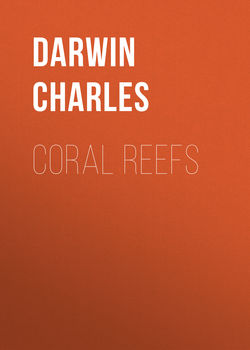Читать книгу Coral Reefs - Чарльз Дарвин, Darwin Charles - Страница 4
THE STRUCTURE AND DISTRIBUTION OF CORAL REEFS
(DESCRIPTION OF THE PLATES
ОглавлениеPLATE I. – MAP SHOWING THE RESEMBLANCE IN FORM BETWEEN BARRIER CORAL-REEFS SURROUNDING MOUNTAINOUS ISLANDS, AND ATOLLS OR LAGOON ISLANDS.)
In the several original surveys, from which the small plans on this plate have been reduced, the coral-reefs are engraved in very different styles. For the sake of uniformity, I have adopted the style used in the charts of the Chagos Archipelago, published by the East Indian Company, from the survey by Captain Moresby and Lieutenant Powell. The surface of the reef, which dries at low water, is represented by a surface with small crosses: the coral-islets on the reef are marked by small linear spaces, on which a few cocoa-nut trees, out of all proportion too large, have been introduced for the sake of clearness. The entire ANNULAR REEF, which when surrounding an open expanse of water, forms an "atoll," and when surrounding one or more high islands, forms an encircling "barrier-reef," has a nearly uniform structure. The reefs in some of the original surveys are represented merely by a single line with crosses, so that their breadth is not given; I have had such reefs engraved of the width usually attained by coral-reefs. I have not thought it worth while to introduce all those small and very numerous reefs, which occur within the lagoons of most atolls and within the lagoon-channels of most barrier-reefs, and which stand either isolated, or are attached to the shores of the reef or land. At Peros Banhos none of the lagoon-reefs rise to the surface of the water; a few of them have been introduced, and are marked by plain dotted circles. A few of the deepest soundings are laid down within each reef; they are in fathoms, of six English feet.
Figure 1. – VANIKORO, situated in the western part of the South Pacific; taken from the survey by Captain D'Urville in the "Astrolabe;" the soundings on the southern side of the island, namely, from thirty to forty fathoms, are given from the voyage of the Chev. Dillon; the other soundings are laid down from the survey by D'Urville; height of the summit of the island is 3,032 feet. The principal small detached reefs within the lagoon-channel have in this instance been represented. The southern shore of the island is narrowly fringed by a reef: if the engraver had carried this reef entirely round both islands, this figure would have served (by leaving out in imagination the barrier-reef) as a good specimen of an abruptly-sided island, surrounded by a reef of the fringing class.
Figure 2. – HOGOLEU, or ROUG, in the Caroline Archipelago; taken from the
"Atlas of the Voyage of the 'Astrolabe,'" compiled from the surveys of
Captains Duperrey and D'Urville; the depth of the immense lagoon-like space within the reef is not known.
Figure 3. – RAIATEA, in the Society Archipelago; from the map given in the quarto edition of "Cook's First Voyage;" it is probably not accurate.
Figure 4. – BOW, or HEYOU ATOLL (or lagoon-island), in the Low Archipelago, from the survey by Captain Beechey, R.N.; the lagoon is choked up with reefs, but the average greatest depth of about twenty fathoms, is given from the published account of the voyage.
Figure 5. – BOLABOLA, in the Society Archipelago, from the survey of Captain Duperrey in the "Coquille: " the soundings in this and the following figures have been altered from French feet to English fathoms; height of highest point of the island 4,026 feet.
Figure 6. – MAURUA, in the Society Archipelago; from the survey by Captain
Duperrey in the "Coquille: " height of land about eight hundred feet.
Figure 7. – POUYNIPETE, or SENIAVINE, in the Caroline Archipelago; from the survey by Admiral Lutke.
Figure 8. – GAMBIER ISLANDS, in the southern part of the Low Archipelago; from the survey by Captain Beechey; height of highest island, 1,246 feet; the islands are surrounded by extensive and irregular reefs; the reef on the southern side is submerged.
Figure 9. – PEROS BANHOS ATOLL (or lagoon-island), in the Chagos group in the Indian Ocean; from the survey by Captain Moresby and Lieutenant Powell; not nearly all the small submerged reefs in the lagoon are represented; the annular reef on the southern side is submerged.
Figure 10. – KEELING, or COCOS ATOLL (or lagoon-island), in the Indian Ocean; from the survey by Captain Fitzroy; the lagoon south of the dotted line is very shallow, and is left almost bare at low water; the part north of the line is choked up with irregular reefs. The annular reef on the north-west side is broken, and blends into a shoal sandbank, on which the sea breaks.
